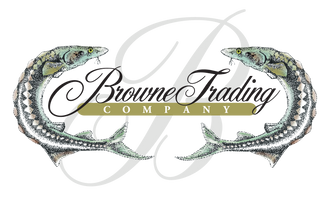COMMONLY REFERRED TO AS “Black Cod”, “Alaska Cod”, or even “Butterfish”, sablefish is not actually a member of the cod family, nor is it the true butterfish. Rather, it is of the family Anoplopomatidae, which is confined to the icy waters of the Pacific Northwest. Due to its extremely high oil content for a white fish, sablefish is renowned for its rich, buttery flavor. It’s no wonder sablefish bears the alias of “butterfish”. In actuality, the true name is derived from the small, dark brown to black scales, which feel almost velvety to the touch – similar to the fur of a sable.
Our farmed sablefish hail from the only commercial sablefish farm in the world, located in Kyuquot Sound, which is northwest of Vancouver Island. Here, they are raised in sea-pens that are almost 100 feet deep – replicating the darker bottom conditions this deep-sea species requires to grow naturally. Raised on specially-formulated organic diets (marine certified 100% fish oil and meal with no hormones or colorants) the sablefish thrive in stocking densities which are lower than most other organic stocks. Harvested upon demand, they are drawn up slowly from the depths and humanely harvested with a traditional Japanese method that eliminates any tissue damage.
In the wild, sablefish are caught in deep waters off the Pacific coast, ranging from Baja all the way to Alaska, mostly with longlines, pots, and sunken gill nets. Average size is approximately 10 pounds, but some individual fish have grown to 100 pounds, and have even been estimated by fishery scientists to live up to 90 years of age. Sablefish are long and sleek, distinguished by their dark brown, gray or black scales. Much of the U.S. and Canadian catch is exported to Japan, where it is highly prized for sushi, but it is gaining popularity in America’s fine dining establishments.
The moist, velvety white fillets of sablefish can be baked, poached, broiled, grilled using a grill basket, or pan-fried. Whole fish (or large fillets) can be roasted with the skin left on. Because of its oil content, it is rich with Omega-3 fatty acids, and can stay moist when both barbecuing and smoking (a technique common for centuries among the indigenous tribes of the Pacific Northwest). However, care should be taken by the inexperienced: it is not suitable for most codfish recipes.
Initially available only to the Japanese, and later European markets, the “Kyuquot Sound Sablefish” has now found its way into the U.S. It is available fresh – not prefrozen – and is considered sushi-quality and can be served in raw preparations. These fish are available whole, gutted and head on, between 4 to 6 pounds, or as two fillets approximately two pounds in total weight.
Harvest Region: Northern Vancouver Island, British Columbia, Canada
Seasonality: Year Round
Yield (Fillet Percentage): 54%
Flavor Profile: Buttery
Texture Profile: Soft, velvety with large flakes
Substitute:





